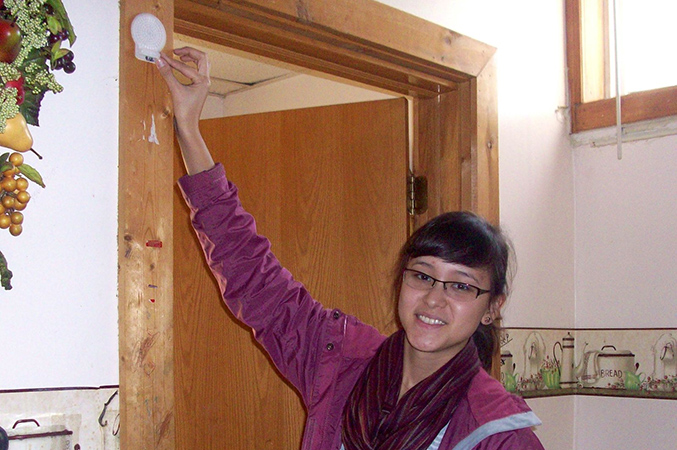In-home education interventions can reduce risk of lead exposure for children, which remains a problem in many parts of the country.
Researchers at the University of Michigan School of Public Health and School of Social Work, and community partners from Healthy Homes Coalition (HHC) of West Michigan, a nonprofit serving Kent County, Michigan, developed a training to engage parents on how to reduce their children’s exposure to lead. Researchers and community partners also developed a separate training curriculum to increase the educators’ self-efficacy in delivering training in the face of burnout. A May 2022 paper describes how the partnership developed this unique training program.
“This project was possible because of the relationship we had built with HHC from our prior work while establishing a Children’s Environmental Health Center — a former NIEHS program,” reflected Alison Miller, Ph.D., who served as Director of the Community Outreach and Translation Core of University of Michigan’s Children’s Center, funded by NIEHS and the U.S. Environmental Protection Agency. “Partnerships are critical to this type of community engagement work where we as researchers support the community partners who are really driving the program based on residents’ needs.”
HHC parent volunteers and peer educators participate in HHC activities. (Photo courtesy of HHC)
Visiting Homes to Deliver Lead Mitigation Training
In 2014, a community health survey in Kent County indicated that half of residents lived in homes built before 1978 and were therefore at risk of lead paint exposure. Additionally, many children had documented elevated blood lead levels. HHC had worked to address these concerns before engaging with the academic researchers. For example, HHC supported efforts to remediate lead in homes of low-income residents with young children and conducted community outreach, but they wanted to expand program offerings to include parent-focused, in-home lead prevention education. Having partnered with the researchers on community outreach projects in the past, HHC approached the research team for assistance developing an educational curriculum to engage underrepresented parents of children at risk for lead exposure in and around the city of Grand Rapids.
Researchers and HHC staff developed a Lead 101 curriculum that followed a conceptual framework that encourages parents to take action for their children, thereby promoting positive outcomes for themselves, their families, and their community.
Through outreach efforts, HHC community partners recruited 62 families to receive training through home visits by trained peer educators. During each home visit, peer educators presented evidence-based materials that demonstrated how lead exposures can occur in the home and how such exposures can be harmful to children. The peer educators then toured the home with families, indicated potential home sources of lead exposure, and demonstrated how to reduce exposure by regularly cleaning up dust and using lead-safe mopping practices, for example.
The peer educators also left educational materials for each family to reference. Parents were informed of the benefits of reducing their children’s lead exposure and of engaging with local community groups that address lead exposure prevention.

An HHC home visitor provides services in a resident’s home. (Photo courtesy of HHC)
Reflective Practice Training Addresses Health Worker Burnout
While facilitating the Lead 101 program, peer educators and other HHC staff experienced stressful situations, such as helplessness to address some families’ difficult living circumstances. Therefore, HHC was interested in addressing possible burnout. The team developed a training curriculum to address burnout by incorporating reflective practice concepts and activities. A social worker on the team facilitated the training.
“The Reflective Practice curriculum for community health workers was a novel effort we didn’t see addressed in existing literature,” reflected Miller. “There is a large body of evidence on using reflective practice to help address clinician burnout. While community health workers’ experiences differ, some of the same elements are there, like working directly with people under stressful circumstances to address health concerns. Our interdisciplinary research team adapted this training to the unique work of the community health professionals and included strategies that have been shown to help burnout.”
The training encouraged the community health professionals to reflect on their experiences visiting residents’ homes, and to describe their emotional and physical responses at the times they felt overwhelmed. Some of the workers described seeing pest infestations and other difficult living conditions that they themselves had experienced, triggering strong emotional reactions. The facilitator directed the group to use strategies such as breathing exercises and body scans to alleviate these responses. The training also described consequences of rumination and provided skills to re-focus attention away from stressful experiences.
Trainings Empower Parents and Community Health Workers
Survey results of the Lead 101 program indicated that parents reported high self-efficacy in reducing their children’s lead exposure following the home visit. Parents indicated they understood sources of lead exposure in the home and intended to take action to prevent exposure.
With regard to the Reflective Practice training, participants indicated they planned to use the techniques in their work. Participants were also satisfied with the training and found it interesting.
In the future, the researchers will support HHC’s efforts to expand their parent-focused work on lead prevention by developing more evaluation criteria to better understand efficacy of the Lead 101 program. HHC ultimately hopes to scale-up Lead 101 in partnership with the local health department. The team also seeks to expand the Reflective Practice training to other public health scenarios—for example with community health workers who address home environmental hazards such as radon, mold, and household chemicals.
HHC staff member and study co-author Jacklyn Hernandez affirmed her enthusiasm for the potential of this work and the power of partnerships. HHC’s focus on parent empowerment encouraged HHC to connect with a wide range of community resources beyond those directly focused on lead prevention, such as Head Start and local food banks.
Hernandez noted, “These partnerships not only helped families out, but also reduced stress on staff because they had a larger network of options to recommend to families – it literally takes a village.”
Source link
www.niehs.nih.gov

